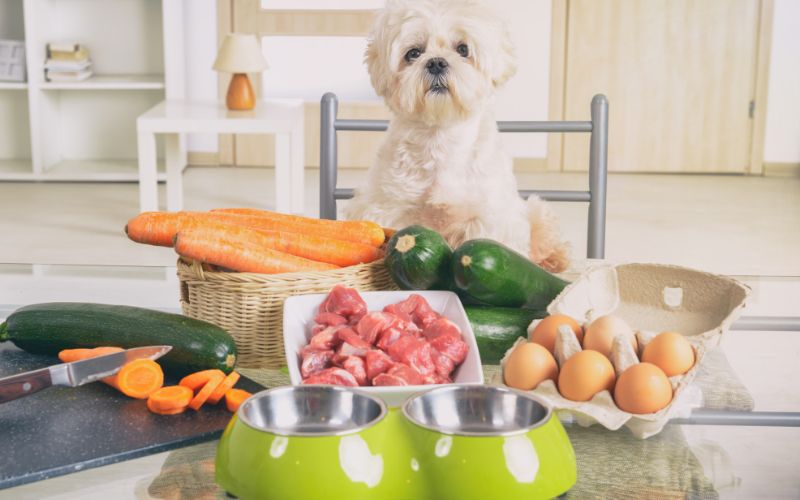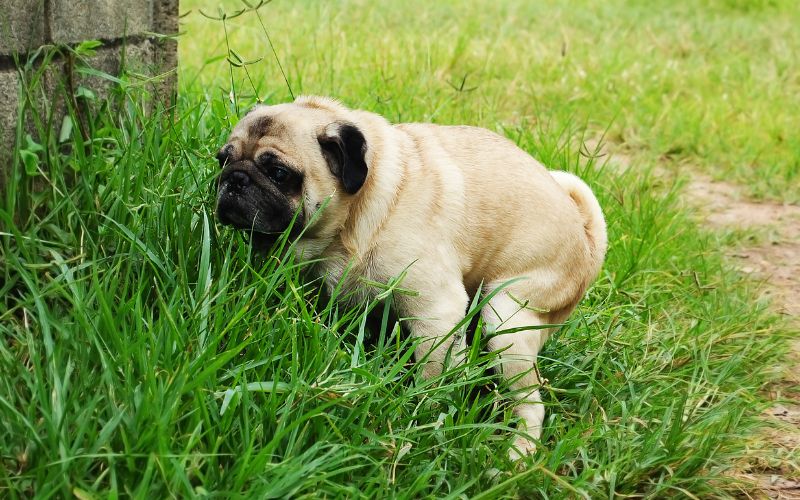When it comes to food, dogs often have a hard time resisting a bite or two. In fact there’s a number of dog breeds, such as Labrador Retrievers and Beagles, that are particularly food-driven and will take any chance they can get to nab a tasty treat.
So if food is such a high value for our dogs and a major part of their everyday life, this(then) begs the question…are we feeding our dogs the best food possible?
Especially if choosing commercial dog food, this comes with a number of health implications and long-term risks.
So, what actually makes dog food healthy or unhealthy? And are there more benefits to feeding your pup commercial dog food or switching over to homemade dog food?
These are all questions we answer right here, as we take a look at the 5 biggest problems with dog food today, uncovering the truth about commercial dog food and offering some guidance on how to find what dog food is best for your four-legged friend.

1. Commercial dog food contains approximately 10% moisture
Kibble, as commercial dry dog food is often called, has almost all the water removed. Why do this? Because if it’s dehydrated it keeps longer, it’s cheaper to transport (less volume) and also easier - or more convenient - for customers to store at home.
Kibble seems to be all about numbers and profit, as opposed to the quality of food itself and your dog’s health.
The dog’s internal system has to rehydrate the kibble in order to break it down and utilise it. This means that the moisture must be taken from somewhere in the body, leaving your dog at risk of dehydration. Kibble is particularly risky for dogs suffering from kidney disease.
What’s the Solution?
Rehydrate the dog kibble before feeding it to your dog. For every cup of kibble, add at least a cup of water or stock - whatever your dog likes most. It isn’t necessary to soak it, although that is better for maximum rehydration.
The only issue with this is that dogs often turn their nose up at it once it has been soaked, as the intensity of flavour from dehydration (and flavour enhancers) which make it more appealing to the nose of the dog are diluted.
Yes, most dogs will drink water after a bowl of kibble, but not until the kidneys tell the dog’s body that they need water.
2. Highly processed commercial dog food is pro-inflammatory
Simply put, it doesn’t matter how expensive or how “high end” the dog food appears, it is still a highly processed food.
You can think of it as the equivalent of the highly processed food humans eat - i.e. fast food - which we know can have long term consequences on our own health. So just think about what impact highly processed dog foods can have on your own canine.
You may have heard of highly processed foods being referred to as ‘empty calories’. Empty calories are typically food and drinks that are high in calories but contain less nutritional value. The risk of consuming a high amount of empty calories is that this can eventually lead to nutritional deficiencies and weight gain.
Unfortunately, a number of commercial dog food brands do utilise ingredients that fall into this ‘empty calorie’ category.

To illustrate; kibble is generally made by cooking/boiling waste products, to form what is called a ‘slurry’ – the stuff that rises to the top – which when cooking for ourselves we normally throw out. The slurry is then dehydrated before being extruded, which compacts it and forces it into a pellet. In the process, a vitamin premix is added to make the kibble meet the dog’s vitamin and mineral needs.
Like the human equivalent of fast food, eating too much of this kind of food for too long culminates and can have a negative effect on the body. The health repercussions of this kind of diet for your dog may include:
- Skin irritations
- Rashes
- Hot spots
- Bare patches
- Redness
- Joint stiffness
- Weeping eyes, and
- Obesity
And that’s most likely just scratching the surface, with some sources suggesting that commercial dog food can be linked to cancer.
What’s the Solution?
Adding an anti-inflammatory product helps to mitigate some of the inflammation. That is why organic hemp oil is one of our favourite anti-inflammatory oils to add to our dogs’ daily meals.
Some sources may suggest fish oil too, such as Omega 3 fish oil, however we would caution you to be aware that some fish oils can be contaminated with mercury.
There are also some very good (human) anti-inflammatory supplements on the market. However, always consult your vet before giving your dog any additional supplements to ensure they are dog-friendly.
3. Commercial dog food contains poor quality protein
Most food has some protein, but good quality protein really comes from living animals i.e. meat.
As most pet parents already know, meat can get expensive. Yet as the goal of most commercial pet food is all about keeping costs down, this means that the ‘protein source’ is often obscure and downright misleading.
In fact, much of the anti-grain movement in pet food is because the protein in kibble was mostly coming from grain and legumes, not meat. The meat source is usually all the nasty bits and pieces (the meat derivatives) that were previously rejected or are the “left over” after all the good bits are extracted.
We know that it can be confusing to actually comprehend how much protein is in a commercial dog food. Reading - and understanding - the labels is an art form in itself. Thankfully the PFIAA has created this handy guide to understanding pet food labels, so you can better understand exactly what is in your dog’s food and its nutritional value.

What’s the Solution?
If in doubt, you can add some good quality protein to your dog’s dinner bowl. It doesn’t have to be expensive either; you can try:
- Eggs
- Cottage cheese
- Plain yoghurt
- Fish - such as sardines (low salt), and
- Any of the cheaper cuts of meat
Here’s some other affordable protein sources you can also add to your dog’s meal.
4. Commercial dog food contains no living food
Let's be honest here, although not all of us love vegetables, vegetables love us and really nourish our bodies. And the same thing can be said for our dogs.
Which makes it even better if your dog food contains vegetables or “living food”, which is a food that has the minimum interference, coming as nature intended with as little processing as possible.
The sad truth is that the majority of commercial pet foods are very rarely a rich source of living food.
What’s the Solution?
Simple; add vegetables to your dog’s daily meal.
Dogs need their vegetables to be cooked or pulverised so that the cellulose is broken down and the vegetables can be more easily digested.
Here’s some ideas to get you started:
- Add steamed and mashed broccoli
- Any leafy greens like Chinese greens
- Cooked and mashed root vegetables like carrot, pumpkin and sweet potato
In fact, here’s a useful list of vegetables your dog can eat.
If you're on a budget, your leftovers are great as long as they are healthy and appropriate for dogs. Just be sure to take out onion, large amounts of garlic and any other foods that may be poisonous to dogs.
5. Commercial dog food contains poor quality fats and oils
Due to the way kibble is processed, the oil used in manufacturing is by definition also treated to high heat, or from disused animal fat, which is highly saturated and not good for your dog’s health (particularly the arteries).
Likewise, oil is occasionally sprayed on the finished commercial dog food product to make it more appealing to your dog. However, the long shelf life requirement means it has to be stabilised, losing most of its goodness.
In our article on Overweight Dogs, we even discuss the risks of saturated fats in dog diets. But what you might not know is that not all fats are bad. Indeed, essential fats can provide energy and help support an overall healthy internal system.

What’s the Solution?
Depending on your dog's weight, add an appropriate amount of good quality, cold-pressed oils to your dog’s dinner bowl. Olive oil is great or you can buy specialist oils from the health food shop like Udo’s Choice, flaxseed oil, cod liver oil or hemp seed oil.
Make sure to rotate the oil you use, so that it offers a range of goodness to your dog. Again, always double check with your vet if you are thinking of changing/adding to your dog’s diet to ensure all elements are safe for your pet to consume.
Another step to take is adding a good quality supplement. Look for ones that have a wide range of wholefoods with minimal processing – such as Wellbeing Essentials Complete 22.
In Conclusion
If you are currently feeding your dog commercial dog food, please know that this article wasn’t written to condemn or judge your choices. Rather, we gathered together this information so you could be more aware as to what processes are used to create dog kibble, and what nutrition your dog may be lacking with this kind of diet.
As a practical first step, especially if cash is tight right now, you can include a few simple additions to your dog’s kibble:
- Add moisture to the dog kibble to avoid dehydration
- Add anti-inflammatory supplements to prevent inflammation
- Add inexpensive protein sources to supplement nutrition
- Add in some veggies to increase nourishment
- Add in some good-quality oils to aid overall wellbeing
Just make sure to consult your vet before making any drastic changes to your dog’s diet.
The great news is that if you do take these steps and include these additions to your dog’s daily meal, you’re already very close to making your dog’s food from scratch anyway. The more involved you can be in what goes into your dog’s bowl, the more nourishment you can ensure they receive in every mouthful.
If you’d like to learn more about the benefits of homemade food for dogs then dive into our article on the topic here.
After all, it’s our belief that homemade food is best. So let’s get cooking!




